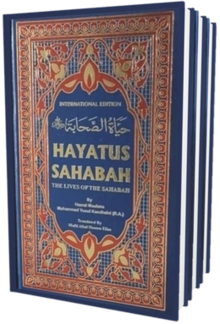 English cover English cover | |
| Author | Yusuf Kandhlawi |
|---|---|
| Original title | حياة الصحابة |
| Language | Arabic |
| Subject | Companions of the Prophet |
| Genre | Biography |
| Publication date | 1959 |
| Publication place | India |
| Media type | |
| ISBN | 978-9695862926 Zam Zam Publishers |
| OCLC | 21989323 |
| Dewey Decimal | 297/.64 full |
| LC Class | BP75.5.K313 1991 |
Hayat al-Sahaba (Arabic: حياة الصحابة) is a book originally written in Arabic by Yusuf Kandhlawi. It was completed around 1959 and later expanded into four volumes with additional annotations and introductions by Abul Hasan Ali Hasani Nadwi and Abd al-Fattah Abu Ghudda. The book was first published for Tablighi Jamaat. It is based on sources such as Hadith, history, and biographies, with a specific focus on the life of Muhammad and his companions (the Sahaba). The book is in nineteen chapters, each addressing specific topics related to the companions.
Content
The original Hayat al-Sahaba is divided into three volumes in Arabic. The first volume, containing 612 pages, discusses the Muhammad's exhortations to individuals, tribes, and groups during Hajj seasons and journeys. It also shares stories of individuals embracing Islam, like Amr ibn al-As, Khalid ibn al-Walid, and Ikrima ibn Amr. Notable companions like Abu Bakr, Umar, and Mus'ab ibn Umayr are also highlighted for their preaching.
In the second volume, the focus shifts to the exhortations, sacrifices, and sufferings of the companions during significant events like wars and migrations. It covers the advice given by Abu Bakr and Umar to their officers during wartime, various pledges (Bay'ah) made by the companions for different causes, and the hardships endured for the sake of spreading Islam. The book also recounts the Hijrah (migration) of Muhammad and his companions, their unity, and support for Islam.
The third volume focuses Jihad and their willingness to spend their wealth for this purpose. It describes battles like the Battle of Badr, the Battle of Uhud, and the Battle of the Yarmuk.
Reception
The Arab News wrote that the book has established itself as indispensable reading for those seeking to understand the Islamic way of life or explain Islam to Muslims and non-Muslims alike. According to Javed Akhatar, a PhD scholar from Jamia Millia Islamia, the book represents a meticulous historical account, chronicling the efforts of personalities who responded to the call of Islam and were steadfast in their belief in God and Muhammad. Muhammad Latif Khan, from the National University of Modern Languages, described the book as a reflective portrayal of the Da'wah (Islamic call), offering profound insights into the conduct and principles of the Companions.
Translation
The English translation of the book was undertaken by Majid Ali Khan, a professor at Jamia Millia Islamia, in a ten-volume set, comprising more than 3000 pages. It was rendered into Turkish by multiple writers: Ahmed Meylani in 1980, a team led by Ahmet Muhtar Büyükçınar as "Hadislerle Müslümanlık" in 1980, and Sıtkı Gülle as "Hayâtü’s-sahâbe: Peygamberimiz ve İlk Müslümanlar" in 1990. Naseer Ahmad from Pakistan obtained the author's permission to publish the book's modern Arabic version in Urdu. It reached Bengali readers through the translation efforts of Mohammad Zubayer, spanning five volumes.
Legacy
The book is about journey of Prophet Muhammad and his companions produced in accordance with Tablighi Jamat. K. Zaheer Ahmed's scholarly efforts culminated in a PhD thesis in 2018 entitled "Al Qiyamul Insaaniyyah Fee Kitaabi Hayaatis Sahaaba Lish Shaykh Muhammad Yusuf Al Kandehlavi Rahimahullah," composed in Urdu at the University of Madras.
See also
References
- Kajee, Imraan; Kajee, Moosa (2018). The legacy of the Ulama of Deoband. South Africa: Spiritual Light. p. 55. ISBN 979-8861344210. Archived from the original on 25 September 2020. Retrieved 7 March 2023.
- ^ Özşenel, Mehmet (1988–2016). "KANDEHLEVÎ, Muhammed Yûsuf". TDV Encyclopedia of Islam (44+2 vols.) (in Turkish). Istanbul: Turkiye Diyanet Foundation, Centre for Islamic Studies.
- ^ Ahmed, K. Zaheer (2018). Al Qiyamul Insaaniyyah Fee Kitaabi Hayaatis Sahaaba Lish Shaykh Muhammad Yusuf Al Kandehlavi Rahimahullah (PhD) (in Arabic). India: Department of Arabic, University of Madras. p. 219. Archived from the original on 16 June 2023. Retrieved 29 July 2023.
- Akhatar 2016, p. 104–106.
- Akhatar 2016, p. 106–108.
- Akhatar 2016, p. 108–111.
- Salahi, Adil, ed. (6 November 2002). "Scholar Of Renown: Muhammad Yusuf Al-Kandhlawi". Arab News. Archived from the original on 14 June 2023. Retrieved 29 July 2023.
- ^ Akhatar, Javed (2016). Jamia Millia Islamias contribution to Islamic studies since 1920 (Thesis). India: Department of Islamic Studies, Jamia Millia Islamia. p. 104. hdl:10603/210671. Archived from the original on 16 December 2023. Retrieved 8 December 2023.
- Khan, Muhammad Latif (2014). Muhammad Yousuf Kandhalwi: Daawati Afkaar Aur Dini Khidmaat (PhD) (in Urdu). Pakistan: National University of Modern Languages. p. 174. Archived from the original on 7 July 2023. Retrieved 29 July 2023.
- "Hayat al-Sahaba (1–5)". Wafi Life. 10 October 2022. Archived from the original on 16 December 2023. Retrieved 29 July 2023.